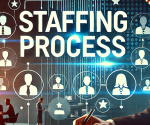Recruitment is the core function of any organization, placing people in appropriate positions to sustain growth, innovation, and efficiency. The concept of recruitment thus revolves around finding appropriate candidates to enlist and put on board to fill specific job positions within an organization. Organizational recruiting is therefore necessary as this helps to construct a professional team according to organizational goals. This article goes into detailed meaning and definition of recruitment, processes, and techniques in-depth.
Concept Of Recruitment
Recruitment is not just about filling vacancies. It is a strategic process that connects the gap between an organization that seeks talent and an organization that seeks talent in achieving its short-term and long-term goals. This process also caters to the needs of job seekers and serves the interests of the employer by forming a mutually beneficial relationship between both.
Recruitment is a process wherein demand for a new role is found, sourcing candidates and usually selecting the most qualified person for a position. Thus, it becomes an active recruitment attempt through a number of platforms whether on job portals, social media, campus recruitments or even making your company an attractive place to work through employer branding.
Knowing what recruitment means provides a distinction between it and the other roles of HR, like selection or onboarding. In other words, recruitment occurs from an organization’s awareness of vacancies up to where resumes by potential candidates reach for more screening. Staffing and recruitment are two different things.
The term recruitment was defined by Edrin B. Flippo very aptly as “The process of searching for prospective employees and stimulating them to apply for jobs in the organization.” These are two very critical elements: attracting suitable candidates for the organization and stimulating them to apply for the jobs within.
Nature of Recruitment
Recruitment is an ongoing process, in a dynamic state and always being influenced by many factors from within and outside. The nature of recruitment portrays the organization’s objectives, job market conditions, and means available for recruitment.
- Dynamic Nature: Recruitment strategies are never fixed and always changing due to market trends, industrial norms, and organizational needs and are constantly evolving. Companies must stay adaptable to attract top talent in a competitive and ever-changing job market.
- Two-Way Process: The recruiter and potential candidate examine each other. Recruitment is interactive, with both the recruiter and candidate assessing each other. Employers evaluate skills and cultural fit, while candidates judge the organization’s values, opportunities, and benefits.
- Objective-Driven: Recruitment is concerned with the proper talent matching the right job, to achieve organizational goals. The primary goal of recruitment is to match the right talent with the right job. This alignment ensures the organization achieves its goals while fulfilling the career aspirations of the candidate.
Phases of Recruitment Process
The recruitment process is a well-defined series of steps to detect, attract, and analyze the candidate appropriately. All of these stages make sure it brings the best-fit talents to the organization without transparency or inefficiency.
Job requirement analysis, making recruitment strategies, and letting people know of vacancies. This will ensure fair and consistent action and thereby fulfill the legal and ethical requirements. A good recruitment strategy minimizes hiring biases and diversifies the workplace.
1. Identification of the Job: The recruitment process starts with the identification of the new job requirements inside an organization. HR goes back to the management discussing workloads, skills deficits, or even project needs. They define the responsibilities that have to be performed, what kinds of skills are necessary for the role, and even qualifications-the very basics of the whole staffing process. Forms a part of the recruitment process.
2. Job Analysis and Description: A job description contains specific duties, qualifications, and experiences required for the given post and must be highly specific. All these documents have critical factors that ensure a correct person has been attracted by explicitly laying down expectations, which enables candidates to weigh their suitability for the job.
3. Sourcing Candidates: Candidates are sourced from a variety of channels; ranging from online portals, social media, and employee referrals to headhunter agencies. In this regard, for the new talents, there exists campus recruitment and attending career fairs in this method, it is possible to tap the potential source of talent to be innovative and contribute.
4. Application Screening: Resumes and cover letters are reviewed to shortlist candidates based on basic qualifications. Automation tools and Applicant Tracking Systems make the process easier, saving a lot of time and assuring that only the most relevant applications are considered for further evaluation.
5. Interviewing Candidates: It involves interviews, customized to gauge technical knowledge, cultural fit, and behavioral traits. Multilateral interviews, technical, managerial, and HR are widely conducted in large organizations to ensure that there is the right assessment of the individual’s aptitude and fit with the culture of the organization and the organization’s requirements.
6. Assessment as well as Testing: Depending upon the needs of the companies, aptitude tests, technical assessments, or psychometric assessments are provided to the applicants. The outcome of such tests will provide insight into the problem-solving and technical skills and personality profile; therefore, the best candidate could be picked.
7. Reference and Background Checks: Before finalizing a candidate, organizations verify their credentials and conduct background checks. This step reduces risks by confirming the candidate’s honesty, work history, and suitability for the role, ensuring a reliable hire.
8. Job Offer and Negotiation: Final Steps Finally, a word has to be extended to the selected candidate for the particular position. Human resources thereafter negotiates aspects like salaries, benefits, and joining dates for alignment purposes along with expectations of the candidate and policies of the organization. A well-negotiated offer leads to building trust and employer-employee relations.
Recruitment Techniques
Various recruitment methods utilized in the past were traditional and also modernized. The method chosen is solely based on the goals of the organization, the budget, and the complexity of the job.
Traditional Techniques of Recruitment
While traditional recruitment methods have been around for centuries, dating back as far as the Mediaeval period when candidates would seek employment through their local town crier; it wasn’t actually until the 20th century that the recruitment industry as we know it started to take shape. The techniques followed during those days for recruitment are mentioned below:-
1. Newspaper Advertisement: Suitable for a wider spread when the job does not necessarily require very specialized skills. It is very expense-free for small and medium firms.
2. Internal Recruitment: It is promoting the existing employees or transferring them to other jobs. It saves a lot of time for new joiners and encourages people to stay in the company.
3. Employment Agencies: Agencies are used in the search for special role positions or when there is little time.
4. Campus Recruitment: The most widely used selection process for fresh graduates. The firms visit campuses for a recruitment process known as placement drives.
Modern Recruitment Practices
Today, we are living in a digital world where everything has the potential to be streamlined and optimized for maximized productivity and revenue. While traditional recruitment methods are still used, modern recruitment strategies offer a lot of benefits that can’t be ignored, including increased efficiency, improved productivity, and a larger pool of candidates.
1. Online Job Portal: LinkedIn, Indeed, and Glassdoor are some big portals with this source, providing an ocean of candidates. This portal provides advanced filtering options and shortlists candidates based on their requirements.
2. Social Media Recruitment: They are used in posting jobs on different social media platforms like LinkedIn, Facebook, and Twitter. Also helps in engaging passively.
3. Employee Referrals: Refer friend program wherein some incentives are provided to reward the employees as a motivation for referring potential hire candidates, is believed to attract quality hire and usually reduces the hiring cost, most of the time
4. Artificial Intelligence Recruitment: AI recruitment tools include chatbots making the candidate experience easier. The analytics helps in simplification for sourcing and screening of people.
The talent management strategy of an organization revolves around its backbone of recruitment. An organization can bring home the right workforce to realize the organization’s vision and goals by efficiently developing techniques and best practices. Besides this, it cements operational excellence while forming a culture of trust and cooperation.
Concept Of Recruitment FAQs.
What is the difference between recruitment and selection?
It includes the attraction of applicants to the role and it also involves evaluation and selection of the right candidate for the place offered.
What are the internal and external methods for recruitment?
Internal recruitment refers to filling the places by people who are already involved in the organization whereas external one involves fresh talent from the job portal, social media, or taking the help of the recruitment agency.
In what ways does AI augment recruitment?
AI automates the screening, shortlisting, and engagement of candidates. This saves time and is objective.
Why is diversity important in recruitment?
Diversity leads to innovation, effective decision-making, and a better workplace culture through different perspectives and ideas.
What role does employer branding play in recruitment?
Employer branding will build an excellent reputation for a company. This means that it is likely to attract the best talent there is and also ensures that retaining them won’t be problematic.


